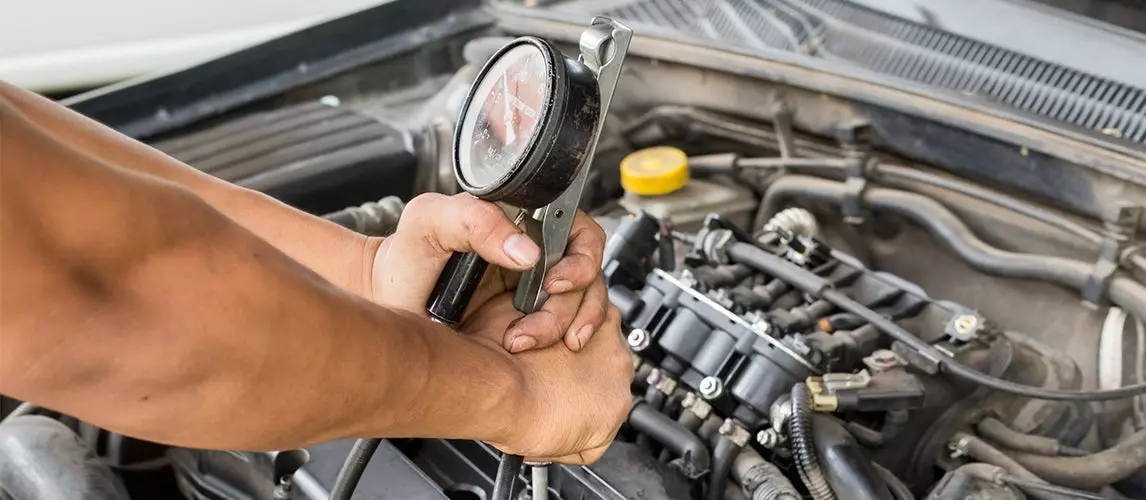Performing an engine compression test can help detect pressure leaks such as those coming from the piston rings, valves, and cylinders. It can also help identify a potential problem with the head gasket. The best part of a compression test is that there is no need to take down the engine. Here’s how to do a compression test.
Related Post: Best Compression Testers
Preparation
When performing a compression test on your car’s engine, there are a few things you should keep in mind. First, make sure that your battery has a full charge. This will help prevent getting erroneous compression readings. Second, it is important to get the right compression gauge that is appropriate for your car’s engine. For example, diesel engines require compression gauges with higher tolerances than those for gasoline engines.
It is also critical to warm up the engine before you start with the test. This will help the pistons expand, forming a proper seal. Warming the engine prior to the test can also facilitate the optimum functionality of the valves. To warm up your engine, you can drive your car for about 15 to 20 minutes around the neighborhood. An alternative will be to let the engine run at idle for at least 15 minutes. Make sure to open the garage door if you opt for this approach.
Once warmed up, turn off the engine and let it cool. If the engine is too hot, you may want to let it cool down for at least an hour. Remove the relay for the fuel pump so you will avoid pumping fuel into the cylinders. If your car has an electronic fuel injection system, you may want to remove the fuse for it.
Get a screwdriver and block the throttle to keep it open. You will want enough air to go into your engine during the test. If you have a carburetor, take out the air filter box. If your car comes with a throttle body, then disconnect the duct of the air cleaner. For diesel engines, it is also necessary to disengage the fuel shutoff solenoid to help prevent the injection pump from functioning.
Start the car’s engine. This will help use up the fuel that remains in the system lines. Keep the engine running until it stalls. Once the engine stalls, you can start disabling its ignition system by disconnecting the ignition coil pack’s electrical connection.
By the time you get to this part, you’re ready to disconnect the wire of the spark plug closest to the engine’s front. Always grab the wire by its boot, never the wire itself. Twist it in a gentle back and forth motion. Make sure to put a label on the wire so you know where to put it back. Do the same with the rest of the spark plug wires.
Clean the spark plug well before removing it. This will help prevent debris and dirt from falling into the engine’s cylinders during the removal of the spark plugs. Remove the spark plugs, paying attention to their placement in the engine. Be careful when handling the plugs.
Performing the Test
To perform the engine compression test, get the appropriate compression gauge for your vehicle. Install it on the first cylinder where the spark plug should be. Tighten the connector to form a seal in the cylinder. This will help prevent erroneous compression readings. Some cars may need an adapter to fit into the spark plug hole. This will connect it to the compression gauge.
If the compression gauge does not come with a threaded connector, it often comes with a rubber nipple. Plug this into the hole and hold it in place when performing the engine compression test.
Ask someone to crank up the engine. As your assistant is cranking the engine, watch the needle on the compression gauge as it starts to rise with each crank. Take note of the maximum point or level where the pressure gauge needle pointed. If possible, write this down.
Also, take note of the number of compressions you employed in testing the first cylinder. You should observe the same number of compressions for each of the remaining cylinders. For instance, if you used 4 to 6 strokes in testing the compression of the first cylinder, then the remaining cylinders should also receive 4 to 6 strokes during the test.
The compression gauge has a pressure release valve. Turn this on to help release the pressure and reset the gauge to zero. Disconnect and remove the compression gauge from its attachment to the first cylinder. Install and connect the gauge to the next cylinder. Repeat the same procedure as detailed above.
Interpreting the Results
Learning how to do a compression test is one thing. Knowing how to interpret the results is another. You will need to check the service manual of your vehicle for the minimum and maximum compression values for each cylinder. This will give you an idea whether your engine is performing within the specifications or not.
Gasoline engines often have compression values of 125 to 175 psi. Moreover, the difference in compression values between the highest-compressing cylinder and the lowest-compressing cylinder should be between 15 and 20 psi. Diesel engines often have higher compression values of 275 to 400 psi. The variance between any two of the engine cylinders should not be more than 10%.
If the results of the engine compression test are above the maximum vehicle specification, this often means there is a buildup of carbon in the cylinders.
If the results are lower than the minimum specification, then there are two possible explanations. If the compression values are low in two adjacent cylinders, this often means a leaking head gasket. If the compression values are low across all cylinders, then a worn out timing belt or chain is possible. It is also possible that the cylinders or rings are no longer working as they used to. You are looking at a potential engine overhaul.
An engine compression test can tell you a lot about your car’s engine without taking it down. This way, you will know what steps you need to take next.
Sources:
- How to Do a Compression Test – 2CarPros
- How to Perform a Compression Test on Your Engine – Live About









